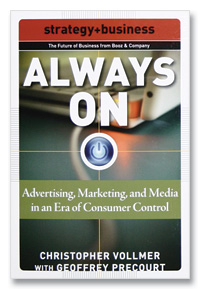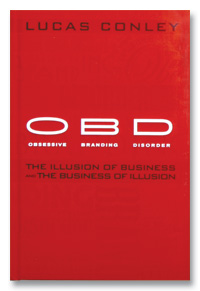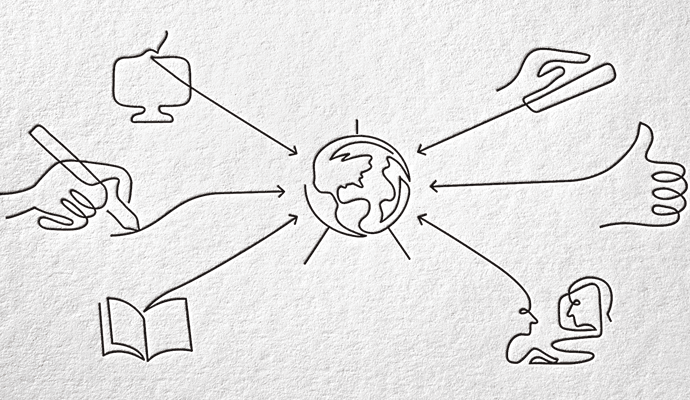Best Business Books 2008: Marketing
The Brand’s New World
(originally published by Booz & Company) Charlene Li and Josh Bernoff
Charlene Li and Josh Bernoff
Groundswell: Winning in a World Transformed by Social Technologies
(Harvard Business Press, 2008)
Christopher Vollmer, with Geoffrey Precourt
Always On: Advertising, Marketing, and Media in an Era of Consumer Control
(McGraw-Hill, 2008)
Lucas Conley
Obsessive Branding Disorder: The Illusion of Business and the Business of Illusion
(PublicAffairs, 2008)
Where there’s mystery, there are sure to be book sales. And even the most studied marketing practitioner, if being entirely honest, might admit that it’s a mystery why “Just do it” has proved such an enduring tagline for Nike, or how Starbucks, which has eschewed traditional marketing, has built such a strong brand. Thus, marketing professionals regularly unleash tomes upon the unwashed masses who inhabit corporate America, attempting to answer the unanswerable: why and how marketing works. That said, there’s something different about some of this year’s crop of marketing books, and as I went through the difficult and at times tedious process of deciding which books to review, a few rose to the top of the pile.
What was different about the best books? They focused on the fact that everything marketing practitioners thought they knew about the craft has changed irrevocably, altered by a technology-fueled upheaval in the established world order. What used to be a tidy one-way message delivery system, in which marketers used advertising agencies to create and place ads in media where the target customer was sure to see them, is now a two-way free-for-all with consumers front and center in the discussion.
Today, not only do consumers have myriad media options, including hundreds of cable channels, millions of Web sites, and commercial-free satellite radio, they also have the newfound ability to talk back to marketers via Weblogs, chat rooms, and other social media. So as marketers try harder than ever to make an impact on consumers, consumers are turning away from ads and defining brands for themselves. To a great extent, the historical lessons of marketing have become irrelevant.
Therefore, I swiftly tossed aside books on branding in the new China, books on how to market to men (and women and children, too), and even one on the cutting-edge practice of mobile advertising. The fine points of particular targets or media channels just don’t matter until marketers get a handle on the larger concept of how to reach, and listen to, increasingly empowered consumers. The easiest book to cast aside was the one that promised to revive “the lost art of creating killer slogans.” At a time when the next killer slogan might be delivered via YouTube by a passionate fan, pretending that marketers can focus on old tools to reach, let alone persuade, consumers seems hopelessly misguided.
The three best marketing books of the year all explore the forever-changed marketing landscape, but from different viewpoints. One focuses on consumers’ ability to talk publicly about, and with, marketers, and how that should impact not just brand strategy, but even corporate strategy. The second is a comprehensive take on how radically things have changed in marketing, mixing in social media as a key ingredient, but far from the only one. And the third, the only consumer-focused book of the group, explains the cacophony that results when marketers, beset by the increasingly difficult task of trying to get noticed, raise their branding initiatives to obsessive levels. Case in point: Cheetos-brand lip balm.
 Surfing the Groundswell
Surfing the Groundswell
Most marketers are having trouble navigating this new landscape. In a recent study conducted by Booz & Company, only 26 percent of marketers said they felt their organization was digitally savvy. The irony, and one that is dealt with beautifully in Groundswell: Winning in a World Transformed by Social Technologies, is that those marketers who harness digital channels to listen to and interact with consumers can strip away many of the behavioral mysteries that have constrained their effectiveness in the past. Written by Charlene Li and Josh Bernoff, two longtime analysts with the Cambridge, Mass.–based technology consultancy Forrester Research (Li left the company in July 2008), the book explores the role of all forms of social media — from blogs to wikis to corporate-sponsored forums — in capturing the momentum generated by consumer wants, needs, opinions, and desires.
Although any book that discusses new media technology tends to contain 30,000-foot philosophizing (Li and Bernoff advise, Zen-like and in italics, that readers concentrate on the relationships, not the technologies), ultimately what makes this one a must-read and the best marketing book of the year is its practicality. Using more than two dozen case studies from organizations including Dell, Memorial Sloan-Kettering Cancer Center, Unilever, and Lego, the book gives explicit instructions on how to tap into the groundswell, defined here as “a social trend in which people use technologies to get the things they need from each other, rather than from traditional institutions like corporations.”
The foundation of the book is a tool called the Social Technographics Profile, available free online, which allows companies to discover whether and how their target customers use social media. This profile identifies target audiences as content Creators; Critics, who comment on already existing products and services or comments; or more passive participants in the groundswell who act as Collectors, Joiners, Spectators, and Inactives. Thus, a company with an Inactive target customer might not require a social strategy at all, whereas a company whose customers tend to be Critics might provide them the opportunity to post ratings and reviews.
The ability to tap into the groundswell may be even more important for companies in crisis, because social media is increasingly contributing to and even starting crises, according to Li and Bernoff. They illustrate this reality with the “Dell Hell” case, which is recounted in exhaustive and instructive detail.
To briefly recap, in 2005, high-profile blogger Jeff Jarvis told the tale in a series of posts of his “lemon” laptop and Dell’s failure to repair it. Jarvis’s first post, headlined “Dell lies. Dell sucks,” garnered more than 250 comments, but that was just the beginning. Soon, thousands of people posted remarks around the Web in support of Jarvis and his blog, and Dell’s poor reputation for customer service worsened as consumer complaints about its responsiveness rose to the top ranks in Google searches that included the company’s name. It was one of the first digital-age public relations disasters.
To its credit, Dell got the groundswell message. Today, it has a full-blown social media strategy, a staff of more than 40 in its communities and conversations group, a chief blogger, and a commitment from CEO Michael Dell to have an ongoing, authentic relationship with its customers. What Groundswell does particularly effectively, in this instance, is to describe Dell’s evolution in terms that make it easy for even the biggest technophobe in corporate America to understand how the company created and executed its strategy, and why it is so important.
The authors also demonstrate how companies can use the groundswell to learn things about their customers they otherwise never would have known. For instance, Memorial Sloan-Kettering discovered through a proprietary online community that its patients did not choose the cancer hospital because of its reputation. The patients, it turned out, were too terrified and distracted to make the decision themselves, and relied heavily on the recommendation of their primary care physicians. This insight led to greatly increased outreach to community doctors, a target the hospital had previously overlooked.
With so many digital corporate marketing priorities vying for attention these days, it would be easy for companies to put off Groundswell — both the book and the concept — for another day. My guess is that Michael Dell, and the leaders of the other featured companies, would disagree with that decision.
 The Evolving Ecosystem
The Evolving Ecosystem
Whereas Groundswell focuses exclusively on social media, Always On: Advertising, Marketing, and Media in an Era of Consumer Control, by Booz & Company Partner Christopher Vollmer, who heads the firm’s media and entertainment practice, written with founding Adweek editor Geoffrey Precourt, helps marketers, agencies, and media companies understand the larger context of the consumer-in-control era, from the splintering of media channels to the development of new metrics for measuring advertising effectiveness.
It may seem disingenuous to choose a book for this essay that was written by an author I know and that was published under the strategy+business brand, so let me say that I did not expect Always On to make the cut. The book’s ambitious mission is rather unwieldy, and I doubted it was possible to achieve it and still be forthright about the earth-shattering effects that the digitally wrought changes in consumer media behavior have had on the marketing and media ecosystem.
But Vollmer delivers. His book both provides the wake-up call that many of us still need and accurately presents the promise that digital media — with its endless stream of consumer behavior data — can have for marketers, agencies, and media companies. It’s also extremely honest about how high the stakes are. In a chapter devoted to the predicament of ad agencies, many of which are still largely wed to making 30-second commercials, the book quotes Jerri DeVard, former Verizon Communications senior VP of marketing and brand management: “[The agencies are] evolving too slowly. They are holding onto the past and trying to rationalize it.” At another point, Vollmer writes, “Marketers will never dominate consumers the way they once did. But they can use this deeper, more informed data-driven analysis to become partners with consumers.” Although one quote is dispiriting and the other hopeful, they both illustrate Always On’s objectivity and credibility, qualities that marketing books, which often read like the commercials they write about, tend to lack.
Always On is so packed with information and advice on how to transform marketing, media, and advertising agencies that it may take a second read to assimilate it all. Every hot-button issue is addressed here, including the controversy over how to measure a consumer’s engagement with particular ads and the increasing impact of technology companies, such as Google, Yahoo, and Microsoft, on the advertising business.
Always On differentiates itself by pegging the revolution in the marketing and media world not just to the technological empowerment of consumers but to the consumer insights the technology reveals. The second chapter opens like this: “There is one overriding, simple, but powerful message for all twenty-first-century marketing, media, and advertising executives: insight about consumers is the currency that trumps all others.” The thirst for consumer insights has given vast power to digital media companies, and it has been the driving digital strategy for major marketers, such as Johnson & Johnson and Procter & Gamble, both of which have become online publishers themselves. For all the reading and writing I’ve done on the topic of digital media since the mid-1990s, I’ve never seen this stated in such a declarative way. In fact, executives throughout the marketing ecosystem could benefit from having a mentor pull them aside, and whisper, Graduate-like, in their ear: “Consumer insights.” Or they could simply pick up a copy of Always On.
The one quibble I have with the book is in its opening chapter, in which the authors document Nike’s March 2007 decision to shift a key part of its business from longtime agency Wieden+Kennedy to Crispin Porter + Bogusky, a Miami-based agency that has successfully disregarded the rules of the mainstream advertising business and assimilated digital into its offering. The move was widely seen as a seminal moment in the shift to digital marketing. By May 2008, however, after the book was published, Nike had returned its business to Wieden. The lesson: As much as the marketing world is changing, some things never change, including the fickleness of agency relationships. But this shouldn’t detract from Always On’s core credibility. The revolution in the marketing and media ecosystem is very real, and this book has the courage to tell it like it is — and to tell marketers, media companies, and agencies what to do about it.
 Dysfunctional Branding
Dysfunctional Branding
Just in case readers of Groundswell and Always On still don’t understand that marketing is no longer about being the loudest, most pervasive brand on the block, they need to read Lucas Conley’s Obsessive Branding Disorder: The Illusion of Business and the Business of Illusion. Conley, who has written for the Atlantic and Fast Company, among other publications, calls into question how deeply, and often weirdly, the corporate urge to brand has gone. “Clearly our obsession with branding has gone too far,” he writes, “when priests are peddling Disney, liquor brands are sponsoring weddings, and mothers are selling the rights to name their children.” (Yes, these marketing “initiatives” actually happened.)
Conley’s concern over the intrusiveness of branding seems particularly on target now, when technology brings consumers and brands closer, whether or not consumers want, or are aware of, that level of interaction. The book is also a timely read because many marketers are reflexively trying to brand harder in an effort to break down consumer indifference and drown out consumer-created opinions about their brands.
Conley’s problems with what he calls OBD (obsessive branding disorder) are not limited to the idea that practices such as word-of-mouth marketing can violate our humanity. He rightly objects to the use of branding as a replacement for truly innovative products and services, as well as the fact that advertisers mistakenly see branding as an end in itself, whether or not it accurately reflects their products and services — or even whether or not it is promoting a positive image. To illustrate, he points out the battered brand of New Orleans, where in the aftermath of Hurricane Katrina, Mayor Ray Nagin responded to a TV reporter’s question about the city’s high murder rate, saying, “[It is] not good for us. But it also keeps the New Orleans brand out there.”
As an antidote to OBD, Conley cites the examples of Spanish retailer Zara, Google, and In-N-Out Burger, brands that have prospered without large ad budgets. “What unifies these companies isn’t their disdain for advertising,” he writes, “but their initiative in delivering a high-quality product that people like, at good value.”
Obsessive Branding Disorder goes on to detail the lengths to which some modern-day products go to brand themselves. In one hilarious anecdote, Conley recounts a marketing consultant’s idea that carmakers should individualize and brand the sound their turn signals make, because, on an annual basis, drivers spend 18 hours listening to their turn signals.
There’s some phenomenal detail here, particularly because Conley has done on-site interviews with many of his subjects. In a lengthy section about the “sonic branding” company Audiobrain, he describes founder Audrey Arbeeny’s outsized reaction to the voice of a client’s customer service representative. He writes: “[Her] call to the company’s main office number was answered by what sounded to her like ‘a seventy-five-year-old chain-smoker.’ Recalling the experience, she clenches her fists. ‘This is a company with very sexy voices in its ads. Way off brand!’”
Conley isn’t entirely unsympathetic to brand marketers, and his efforts to humanize those who contribute to OBD — and to give credit to some highly unusual marketing ideas — help make the book more than a 200-page rant. He seems awestruck, for instance, by Charmin’s Potty Palooza, a “twenty-seven-room deluxe traveling bathroom facility” that has appeared at the Ohio State Fair and the Super Bowl. “By redefining a visit to the toilet as a commercially viable branding opportunity, Charmin has placed its brand squarely between private and public life,” he writes.
Obsessive Branding Disorder doesn’t offer advice to businesses other than that they should innovate first and brand later. Its main purpose is to raise consumer awareness and skepticism of the deep role that branding plays in their lives. To the extent the book succeeds in that endeavor, marketers must heed its message.
These three marketing books are the year’s best because they depict an advertising and marketing world that is increasingly separate from all of the taglines and 30-second commercials that have crowded our collective consciousness over the last 50 years. In fact, readers of these books should start to find it very odd that old ways of marketing are still so pervasive. That is as it should be: In today’s marketing world, Mr. Whipple has no official place at the Charmin Potty Palooza; the star of the campaign is the rest of us. ![]()
Author profile:
Catharine P. Taylor has covered advertising and marketing for almost 20 years, focusing on the impact of digital media since 1994 and writing for publications including Adweek, Advertising Age, and Wired. Founder of Adweek’s AdFreak Weblog, she currently posts about advertising at her own blog, Adverganza.com, and writes a weekly column, “Social Media Insider,” for Mediapost.


